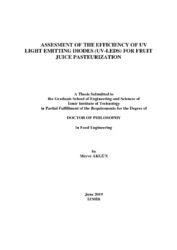Please use this identifier to cite or link to this item:
https://hdl.handle.net/11147/7381| Title: | Assesment of the efficiency of UV light emitting diodes (UV-LEDS) for fruit juice pasteurization | Other Titles: | Meyve suyu pastörizasyonu için UV ışık yayan diyotların etkinliğinin (UV-LED) değerlendirilmesi | Authors: | Akgün, Merve | Advisors: | Ünlütürk, Sevcan | Keywords: | Pasteurization Ultraviolet light emitting diodes Fruit juice |
Publisher: | Izmir Institute of Technology | Source: | Akgün, M. (2019). Assesment of the efficiency of UV light emitting diodes (UV-LEDS) for fruit juice pasteurization. Unpublished doctoral dissertation, Izmir Institute of Technology, Izmir, Turkey | Abstract: | The objectives of this thesis are to evaluate the application of ultraviolet light emitting diodes (UV-LEDs) with various wavelengths for pasteurization of cloudy (CAJ) and clear apple juices (AJ), to assess the disinfection efficiency of combined UV-LED irradiation and mild heat (UV-LED+MH) treatments, to investigate the effect of individual and combined processes on the activity of enzyme, physicochemical and microbiological quality of AJ, to determine the shelf life of UV-LED irradiated juice during storage, to reveal the reactivation potential of target microorganism (E. coli K12) in juice medium with different optical properties, and to elucidate the mechanism of microbial inactivation by UV-LEDs.
280/365 nm UV-LED irradiation assisted by mild heat at 55ºC and 15 min exposure time enhanced the inactivation of E. coli K12 and polyphenoloxidase and satisfied the 5-log reduction pasteurization criterion in apple juice. UV-LED+MH treatment extended the shelf life of CAJ from 3 to 30 days and increased its total phenolic content. However, the color properties were slightly affected by ultraviolet treatment.
Subsequent photoreactivation of E. coli K12 after inactivation by UV-LEDs was observed in both CAJ and AJ. Contrarily, dark repair was repressed at 4ºC and 22ºC, furthermore, a decrease in the survival ratio was recorded in both medium.
It was revealed that the damage of DNA repair enzymes and the proteins that form the outer cellular membrane of bacteria was highly induced by UV-C light at 280 nm. Additionally, the bactericidal effect of 365 nm (UV-A) wavelength was attributed to enhanced production of reactive oxygen species (ROS) resulting in oxidative damage to cellular lipids, proteins and DNA. The combination of these two wavelengths provided more efficient disinfection than that of UV-C light used alone.
UV-LED irradiation assisted by mild heat has a potential to be used as an alternative technique to traditional thermal pasteurization process for juice products. This study leads to useful information for the future design of UV-LED treatment systems. Bu tez, farklı dalga boylarında UV ışık yayan diyotların (UV-LEDs) ve bu dalga boylarının hafif ılımlı ısı uygulaması ile kombinasyonunun meyve suyu pastörizasyonunda uygulanabilirliğinin belirlenmesini, UV-LED ve hafif ılımlı ısıl işlemlerinin ayrı ayrı ve kombineli kullanımının meyve suyunun enzim aktivesi, fizikokimyasal ve mikrobiyal kalitesi üzerine olan etkisinin araştırılmasını, farklı optik özellikteki meyve sularına kontamine edilmiş hedef mikroorganizmanın reaktivasyon potansiyelinin incelenmesini ve UV-LED uygulamasının neden olduğunu mikrobiyal inaktivasyon mekanizmalarının aydınlatılmasını kapsamaktadır. 15 dakika boyunca 55°C'de hafif ısı ile desteklenen 280/365 nm UV-LED ışınlama uygulaması, E. coli K12 ve PPO enziminin inaktivasyonunu arttırmış olup ve elma suyu için 5D pastörizasyon kriterlerini karşılamıştır. UV-LED+MH uygulaması bulanık elma suyunun raf ömrünü 3 günden 30 güne uzatmış olup örneklerin toplam fenolik içeriğini arttırırken, optik özelliklerini olumsuz yönde etkilemiştir. Hem bulanık hem de berrak elma suyu örneklerinde bulunan E. coli K12 hücrelerinde UV-LED (280/365 nm) uygulamasından sonra düşük seviyede fotoreaktivasyon gözlenmiştir. Ancak, hücrelerin karanlık onarım mekanizması 4ºC ve 22ºC'deki inkubasyonlarda çalışmamıştır. DNA onarım enzimlerinin ve bakterilerin dış hücresel zarını oluşturan proteinlerin hasarının 280 nm'de UV-C ışığına yüksek oranda duyarlı olduğu ortaya çıkmıştır. Ayrıca, 365 nm (UV-A) dalgaboyunun biyolojik etkileri, reaktif oksijen türlerinin (ROS) üretimini arttırmış olup, bu ürünlerin hücre içindeki lipid, protein ve DNA üzerinde oksidatif hasara neden olmuştur. Bu iki dalga boyunun kombinasyonu, tek başına kullanılan UV-C ışığından daha verimli bir dezenfeksiyon sağlamıştır. Ilımlı ısıl işlem uygulaması ile desteklenen UV-LED ışınlama, meyve suyu pastörizasyonu için kullanılan geleneksel termal pastörizasyon işlemine alternatif bir teknik olarak kullanılma potansiyeline sahiptir. Bu çalışma, gelecekte tasarlanacak olan UV-LED sistemlerini için yararlı bilgiler sağlayacaktadır. |
Description: | Thesis (Doctoral)--Izmir Institute of Technology, Food Engineering, Izmir, 2019 Includes bibliographical references (leaves: 143-152) Text in English; Abstract: Turkish and English |
URI: | https://hdl.handle.net/11147/7381 |
| Appears in Collections: | Phd Degree / Doktora |
Files in This Item:
| File | Description | Size | Format | |
|---|---|---|---|---|
| T001994.pdf | DoctoralThesis | 2.95 MB | Adobe PDF |  View/Open |
CORE Recommender
Page view(s)
224
checked on Jul 22, 2024
Download(s)
246
checked on Jul 22, 2024
Google ScholarTM
Check
Items in GCRIS Repository are protected by copyright, with all rights reserved, unless otherwise indicated.